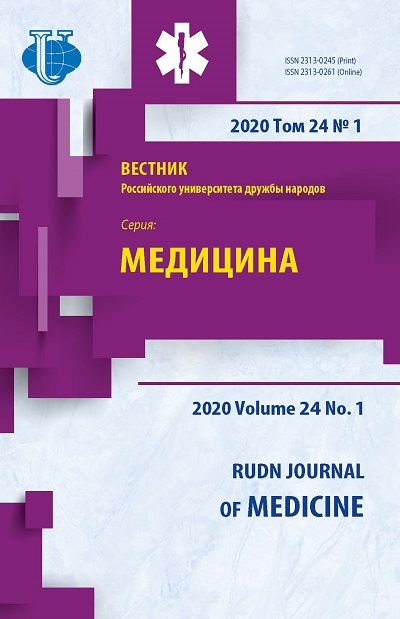State of the antioxidant protection system of rat liver in ischemia and reperfusion
- Authors: Popov K.A.1, Bykov I.M.1, Tsymbalyuk I.Y.1, Denisova Y.E.1, Stolyarova A.N.1, Azimov E.A.1, Shurygina L.A.1
-
Affiliations:
- Kuban state medical university
- Issue: Vol 24, No 1 (2020)
- Pages: 93-104
- Section: PHYSIOLOGY. EXPERIMENTAL PHYSIOLOGY
- URL: https://journals.rudn.ru/medicine/article/view/23399
- DOI: https://doi.org/10.22363/2313-0245-2020-24-1-93-104
- ID: 23399
Cite item
Full Text
Abstract
Purpose: determination of the state of the antioxidant protection system of the cytosolic fraction and suspension of rat liver mitochondria after experimental ischemia and reperfusion. Materials and methods: the study was conducted using white mature rats, divided into 3 groups: the control group (n = 15); The 2nd group of animals (n = 15), from which the liver was taken after 15 minutes of liver ischemia; the 3rd group of rats (n = 15), from which the liver was taken after a 15-minute reperfusion period, followed by a 15-minute ischemic period. Mitochondrial suspension and cytosolic fraction were isolated from liver tissue. Results: the obtained research results showed the presence of certain pathobiochemical changes in the suspension of mitochondria and the cytosolic fraction after ischemia or reperfusion. In the mitochondrial suspension during the reperfusion period it was found an adaptive increase in the activity of glutathione peroxidase by 39% and glutathione reductase by 61%. In the cytosolic fraction, it was the most remarkable increase of the total antioxidant capacity by 38% already during ischemia and a progressive decrease in the level of reduced glutathione form by 26% in ischemic and 55% in reperfusion period. The change in the state of the antioxidant system occurred against the background of an increase in the number of products of oxidative modifications of biomolecules by 40% during ischemia and 2.2 times after reperfusion. Conclusion: The results indicate the need to develop not only a mitochondria-oriented correction of oxidative disorders, but also active support for the components of the cytosol, which provide the main accumulation of free radical damage products and their subsequent removal from the cell, which is essential for survival.
Keywords
About the authors
Konstantin Andreevich Popov
Kuban state medical university
Author for correspondence.
Email: naftalin444@mail.ru
Krasnodar, Russian Federation
Ilia Mikhaylovich Bykov
Kuban state medical university
Email: naftalin444@mail.ru
Krasnodar, Russian Federation
Igor Yuryevich Tsymbalyuk
Kuban state medical university
Email: naftalin444@mail.ru
Krasnodar, Russian Federation
Yana Evgenievna Denisova
Kuban state medical university
Email: naftalin444@mail.ru
Krasnodar, Russian Federation
Anzhela Nikolaevna Stolyarova
Kuban state medical university
Email: naftalin444@mail.ru
Krasnodar, Russian Federation
Erustam Adamovich Azimov
Kuban state medical university
Email: naftalin444@mail.ru
Krasnodar, Russian Federation
Larisa Alekseevna Shurygina
Kuban state medical university
Email: naftalin444@mail.ru
Krasnodar, Russian Federation
References
- Vaos G., Zavras N. Antioxidants in experimental ischemiareperfusion injury of the testis: Where are we heading towards? World J. Methodol. 2017;7(2):37—45. doi: 10.5662/wjm.v7.i2.37.
- Sinning C., Westermann D., Clemmensen P. Oxidative stress in ischemia and reperfusion: current concepts, novel ideas and future perspectives. Biomark. Med. 2017;11(11):1031—40. doi: 10.2217/bmm-2017—0110.
- Khodosovskii M.N. Correction of oxidative damage in the ischemiareperfusion syndrome of the liver. Zhurn GrGMU. 2016;4:20—5. (In Russ).
- Cheng Y., Rong J. Therapeutic potential of heme oxygenase-1/carbon monoxide system against ischemiareperfusion injury. Curr. Pharm. Des. 2017;23(26):3884— 98. doi: 10.2174/1381612823666170413122439.
- Donadon M., Molinari A.F., Corazzi F., Rocchi L., Zito P., Cimino M., Costa G., Raimondi F., Torzilli G. Pharmacological modulation of ischemicreperfusion injury during Pringle maneuver in hepatic surgery. A prospective randomized pilot study. World Journal of Surgery. 2016;40(9):2202—12.
- Basov A.A., Elkina А.A., Samkov A.A., Volchenko N.N., Baryshev M.G., Dzhimak S.S., Moiseev A.V., Fedulova L.V. Influence of deuterium-depleted water on the isotope D/H composition of liver tissue and morphological development of rats at different periods of ontogenesis. Iranian Biomedical Journal. 2019;23(2):129—41.
- Guan L.-Y., Fu P.-Y., Li P.-D., Liu H.-Y., Xin M.-G., Li W. Mechanisms of hepatic ischemia-reperfusion injury and protective effects of nitric oxide. World Journal of Gastrointestinal Surgery. 2014;6(7):122—8.
- Li J., Li R.J., Lv G.Y., Liu H.Q. The mechanisms and strategies to protect from hepatic ischemia reperfusion injury. European Review for Medical and Pharmacological Sciences. 2015;19(11):2036—47.
- Dzhimak S.S., Basov A.A., Volchenko N.N., Samkov A.A., Baryshev M.G., Fedulova L.V. Changes in the functional activity of mitochondria isolated from the liver of rat that passed the preadaptation to ultra-low deuterium concentration. Doklady Biochemistry and Biophysics. 2017;476(1):323—5.
- Bradford M.M. A rapid and sensitive method for the quantitation of microgram quantities of protein utilizing the principle of protein-dye binding. Anal. Biochem. 1976;72:248—254.
- Benzie I.F.F., Strain J.J. The ferric reducing ability of plasma (FRAP) as a measure of “antioxidant power”: the FRAP assay. Anal. Biochem. 1996;239(1):70—6.
- Karpishchenko A.I. Handbook. Medical Laboratory Technology. Sankt-Petersburg: Intermedika, 2002. (In Russ).
- Bykov M.I., Basov A.A. Change of parameters in prooxidant-antioxidant bile system in patients with the obstruction of bile-excreting ducts. Medical news of North Caucasus. 2015;10(2):131—135.
Supplementary files















